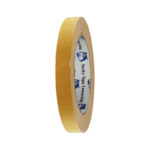When it comes to construction sites, safety is paramount. Properly marking off construction areas not only ensures the safety of workers and visitors but also helps prevent accidents and injuries. Tape is a versatile and effective tool for creating visible boundaries and communicating potential hazards. In this comprehensive guide, we’ll explore the best practices for safely marking off construction areas using tape.
Planning and Preparation: Before marking off any construction area, thorough planning is essential. Assess the site layout, identify potential hazards, and determine the boundaries of the construction zone. Consider factors such as pedestrian and vehicular traffic, nearby structures, and access points.
Selecting the Right Tape: Choosing the appropriate tape is crucial for effective marking. Opt for durable, high-visibility tape designed for outdoor use. Look for tapes online with weather-resistant properties to withstand exposure to the elements and heavy-duty construction activities.
Establishing Boundaries: Use tape to clearly demarcate the boundaries of the construction area. Place tape along the perimeter of the site to create a visible barrier that prevents unauthorised access. Ensure that the tape is securely anchored to the ground or surrounding structures to prevent displacement.
Communicating Hazards: Use tape to communicate potential hazards within the construction zone. Mark areas with uneven terrain, tripping hazards, or restricted access with brightly coloured or reflective tape. Consider using eco friendly sticky tape with pre-printed warning messages or symbols to convey specific safety information.
Creating Safe Pathways: In areas where pedestrian traffic must be redirected around the construction site, use tape to create designated pathways. Clearly mark these pathways with tape to guide pedestrians safely around the work area. Ensure that pathways are wide enough to accommodate foot traffic and are free from obstacles.
Identifying Equipment Zones: Use tape to designate specific zones for construction equipment, storage areas, or vehicle parking. Clearly mark these zones with tape of a different colour or pattern to differentiate them from pedestrian pathways and work areas. Ensure that equipment zones are well-defined to prevent accidental collisions or obstructions.
Maintaining Visibility: Regularly inspect and maintain the tape markings to ensure continued visibility and effectiveness. Replace damaged or faded tape promptly to prevent confusion or accidents. Consider using reflective tape or temporary lighting in low-light conditions to enhance visibility after dark.
Training and Awareness: Provide training to workers and site visitors on the significance of tape markings and the importance of adhering to designated boundaries. Emphasise the need for vigilance and caution when navigating around construction areas and reinforce safety protocols regularly.
By following these guidelines and using tape effectively, you can safely mark off construction areas and minimise the risk of accidents and injuries on-site. Remember that safety is everyone’s responsibility, and proper marking plays a vital role in promoting a culture of safety and compliance in the construction industry.
Benefits of Using Caution Tapes
Using tape to mark off construction areas offers several benefits specifically tailored to the needs of construction sites. Here are some of the key advantages:
Visibility: Tape provides a highly visible barrier that clearly defines the boundaries of the construction area. Its bright colours and reflective properties enhance visibility, even in low-light conditions, reducing the risk of accidental entry or intrusion.
Ease of Installation: Tape is quick and easy to install, allowing construction crews to mark off areas efficiently without significant time or labour investment. This facilitates rapid deployment of safety measures, especially in dynamic construction environments where conditions may change frequently.
Flexibility: Tapes are flexible and can be easily applied to various surfaces, including asphalt, concrete, metal, and plastic barriers. This flexibility enables construction teams to adapt the markings to suit the site layout and accommodate irregular or uneven terrain.
Temporary Marking: Construction projects often involve temporary changes to site layouts or access routes. Tape provides a temporary marking solution that can be easily removed or repositioned as needed without causing damage to surfaces or leaving behind residue.
Cost-Effectiveness: Compared to permanent barriers or signage, tape is a cost-effective solution for marking off construction areas. It offers a balance between affordability and effectiveness, making it accessible for construction projects of all sizes and budgets.
Safety Communication: Caution tape for construction can convey important safety messages or warnings to workers, visitors, and passersby. By using tape with pre-printed symbols or text, construction teams can communicate hazards, restricted access areas, or other safety instructions clearly and effectively.
Compliance: Properly marked construction areas help construction sites maintain compliance with safety regulations and industry standards. By clearly delineating work zones, pedestrian pathways, and restricted areas, tape assists in meeting regulatory requirements and ensuring a safe working environment.
Minimal Disruption: Unlike physical barriers or barricades, tape creates a minimal obstruction to traffic flow and site operations. Its low profile reduces the risk of tripping hazards and allows construction activities to proceed smoothly while maintaining safety standards.
In summary, yellow caution floor tape provides a versatile and effective solution for safely marking off construction areas, offering benefits such as visibility, ease of installation, flexibility, cost-effectiveness, safety communication, compliance, minimal disruption, adaptability, and removability. By incorporating tape into their safety protocols, construction teams can enhance site safety, mitigate risks, and improve overall project efficiency.















